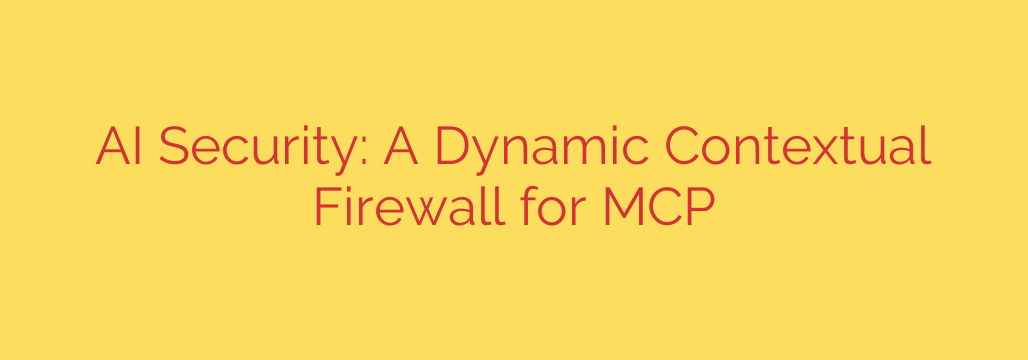
Rethinking AI Security: Why a Dynamic Contextual Firewall is Essential
Artificial intelligence is no longer a futuristic concept; it’s a core component of modern business operations. From automating complex tasks to driving data analysis, AI platforms are mission-critical. But as our reliance on these systems grows, so does their vulnerability. Traditional cybersecurity measures, like static firewalls, are proving dangerously inadequate against the sophisticated threats targeting AI today.
The reality is that securing an AI system is fundamentally different from protecting a standard IT network. AI models interact with data in complex, unpredictable ways, creating unique attack vectors that old-school security tools simply can’t see. It’s time for a smarter, more adaptive approach: the dynamic contextual firewall.
The Flaw in Traditional Security
For decades, firewalls have operated on a simple, rule-based premise. They check traffic against a predefined list of “allow” or “deny” rules based on factors like IP addresses or port numbers. This works well for predictable network traffic, but it fails when confronted with the dynamic nature of AI.
An AI platform is constantly processing new prompts, accessing diverse data sets, and generating unique outputs. A static firewall has no way to understand the intent or context behind these interactions. It can’t distinguish a legitimate, complex query from a malicious prompt injection attack designed to manipulate the model or steal sensitive information.
What is a Dynamic Contextual Firewall?
A dynamic contextual firewall represents a paradigm shift in AI security. Instead of relying on static rules, it analyzes the full context of every interaction in real-time to make intelligent security decisions.
Think of it as the difference between a simple locked door and a highly trained security guard. The locked door only checks for a key (the static rule). The security guard, however, assesses the situation: Who is this person? What are they trying to access? Is their request unusual for this time of day? Is their behavior suspicious?
This intelligent firewall continuously monitors a wide range of contextual factors, including:
- User Identity and Behavior: Who is making the request, and does it align with their typical activity?
- Query Content: What is being asked of the AI? Does the prompt contain suspicious patterns or attempt to bypass safety protocols?
- Data Sensitivity: What data is the AI attempting to access in order to fulfill the request?
- Geographic and Temporal Data: Is the request coming from an unusual location or at an odd time?
- Model Response: How is the AI responding? Is the output appropriate, or does it suggest the model has been compromised?
By analyzing this rich tapestry of information, the firewall can identify and block threats that would be invisible to traditional systems.
Protecting Your Mission-Critical AI from Modern Threats
For any organization leveraging AI in a mission-critical capacity, this advanced level of protection is non-negotiable. A dynamic contextual firewall is specifically designed to defend against the most pressing AI-specific cyberattacks.
Key threats this technology helps mitigate include:
- Prompt Injection and Model Manipulation: Attackers can craft malicious inputs (prompts) to trick an AI into ignoring its safety guidelines, revealing confidential information, or executing harmful commands. A contextual firewall analyzes the prompt’s intent and structure, flagging and blocking these manipulation attempts before they reach the model.
- Data Exfiltration: Sophisticated queries can be used to slowly leak sensitive training data or proprietary information from the AI’s knowledge base. By understanding what data an AI is accessing to generate a response, the firewall can prevent unauthorized data leakage.
- Denial of Service (DoS) Attacks: Overloading an AI with computationally expensive queries can drain resources and render the system unavailable. A dynamic firewall can identify and throttle resource-intensive queries that deviate from normal usage patterns, ensuring system availability.
- Unauthorized Access and Abuse: It ensures that only authenticated users with legitimate needs can interact with the AI, preventing both external attacks and internal misuse.
Actionable Steps to Enhance Your AI Security
Adopting a dynamic security posture is crucial for protecting your valuable AI assets. Here are practical steps you can take to move in the right direction:
- Map Your AI Attack Surface: Identify all your AI models, the data they access, and how users interact with them. You can’t protect what you don’t understand.
- Move Beyond Static Defenses: Recognize the limitations of your current rule-based firewalls in the context of AI. Begin exploring security solutions that offer contextual awareness and behavioral analysis.
- Prioritize Logging and Monitoring: Implement comprehensive logging for all AI interactions. This data is the fuel for a contextual security system and is invaluable for identifying anomalies and investigating potential incidents.
- Implement the Principle of Least Privilege: Ensure users and systems only have access to the specific AI functions and data they absolutely need. This minimizes the potential damage an attacker can cause if an account is compromised.
As AI continues to evolve, so will the threats against it. Securing these powerful systems requires us to move past the rigid, outdated security models of the past. A dynamic, context-aware approach is the only way to build a resilient and trustworthy AI infrastructure for the future.
Source: https://feedpress.me/link/23532/17174422/rethinking-ai-security-dynamic-context-firewall-for-mcp








